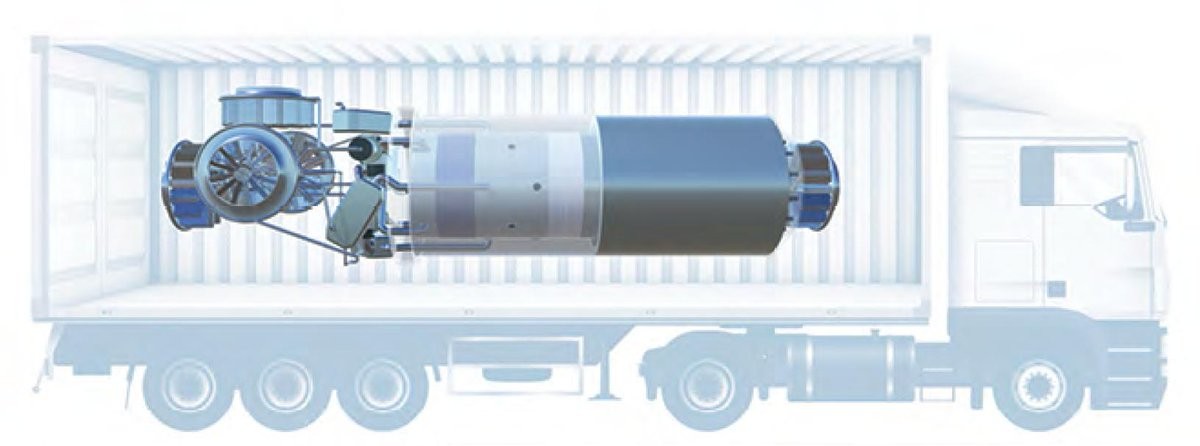 Source: Los Alamos National Lab
Source: Los Alamos National Lab
Developers Race to Design a Fission Micro-Reactor Suitable for Military Use
The U.S. Strategic Capabilities Office of the Department of Defense has requested a proposal for a mobile nuclear-fueled electrical power system. The office is looking to fund three different prototypes before selecting one among them.
Advances in the commercial nuclear industry have driven technology and design trends toward the creation of small mobile nuclear reactors that the industry claims are safe. This makes them a possible choice to reduce the military’s supply vulnerabilities, operating costs and petroleum demand overseas. Nuclear fuel provides the densest form of energy for electricity generation without the need for continuous resupply.
The proposed mobile nuclear power plant (MNPP) would be able to independently deliver up to 10 megawatts of consistent electricity generation needed to maintain quality-of-life utility such as heat and air-conditioning, lighting, and battery regeneration. Its small size would allow for easy transport by land, air or sea to remote operating areas where an electrical grid is unavailable or reinforce existing energy grids to power energy-intensive systems like radar sites, airfields, and ports.
Abundant energy is necessary to advance the tactical logistics of national defense. Combat operations depend on agile readiness in the field, requiring rapid deployment capabilities and the ability to meet force demands in contested environments. Advances in combat technology include energy-intensive equipment that demands denser energy so that it can be deployed for longer periods of time without refueling. Nuclear energy could help meet this challenge.
Illustrating this, more than half (52%) of the deaths during Operation Iraqi Freedom and Operation Enduring Freedom occurred from hostile attacks during liquid fuel resupply convoys. The MNPP would be transported in a 40-foot ISO container which complicates identification and targeting from the opposition; minimizing deadly attacks. This provides additional security that frequent fuel convoys cannot.
Facilitating nuclear power in a small footprint or mobile capacity is not new in the global arena. The U.S. Navy has used mobile nuclear power in its ships for decades. China and India have several micro-nuclear reactors currently in operation. Russia has its own design under construction, and the U.K. is designing a molten salt-based reactor. Developers like Westinghouse and Holtec, are currently in the run to design the U.S. prototype.
The MNPP would be built around heat-pipe technology and run on an advanced encapsulated fuel called Tristructural isotropic (TRISO). TRISCO contains uranium fuel material inside a triple-coated sphere consisting of a core of carbon, coated by silicon carbide, which is then coated by an external shell of carbon. The coatings provide each fuel particle with its own primary containment system, protecting personnel and the environment from radiation exposure. The proposed reactor contains no cooling water or pumps; instead it has an internal regulation system. The nuclear system contains a low amount of enriched uranium preventing the ability to produce a nuclear weapon if captured or stolen. Its claimed meltdown proof design has a minimal logistical footprint and operates semi-autonomously. Once deployed, it is intended to generate power within 72hrs of arrival and shut down in less than seven days—a function never seen before in the nuclear industry.
A few drawbacks of a heavier presence of nuclear power in the military comes down to safety, legislation, and affordability. The risk of radiation released as a result of an kinetic attack in the field is a genuine concern that cannot be overlooked. That being said, there are ways to design and build micro-reactors blueprint make them much safer than we could predict in the past. Given that substantial energy policies needed to de-carb the economy are gaining attention in the U.S., it’s not impossible to include advanced nuclear to the regulatory agenda.
Once a final design has been selected and if funding is dispersed to develop, the MNPP could be ready for final assessment in less than five years. If deployed appropriately, this technology could motivate new nuclear energy policies to accommodate low-enriched nuclear micro-reactors, provide reliable carbon-free energy to our troops, and accelerate sustainable, carbon-neutral energy innovation America.





